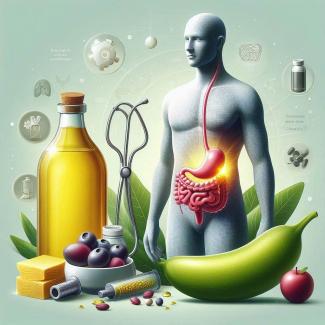
Gallbladder flushing with olive oil, also known as a "gallbladder cleanse" or "liver flush," is an alternative therapy claimed to help expel gallstones and improve gallbladder function. This practice typically involves consuming large quantities of olive oil, often combined with lemon juice or Epsom salts, to stimulate the gallbladder to contract and release its contents.
Is It Healthy and Recommended?
- Medical Perspective: Most healthcare professionals and medical organizations do not endorse gallbladder flushing with olive oil. There is limited scientific evidence supporting its efficacy and safety. Reports of individuals passing stone-like formations after a flush are often due to the formation of "soap stones" (saponified mixtures of oil and digestive juices), not actual gallstones.
- Potential Risks: The procedure can cause nausea, vomiting, diarrhea, abdominal pain, and dehydration. For those with existing gallstones, it may trigger the movement of stones into the bile ducts, potentially leading to serious complications like bile duct obstruction, cholecystitis (inflammation of the gallbladder), or pancreatitis.
How Does Olive Oil Affect the Gallbladder?
Olive oil, especially extra virgin olive oil, is a healthy fat known for its anti-inflammatory and antioxidant properties. It affects the gallbladder in several ways:
- Bile Stimulation: Consumption of fats, including olive oil, stimulates the gallbladder to contract and release bile into the small intestine. This aids in the digestion and absorption of dietary fats.
- Digestive Aid: Regular consumption of moderate amounts of olive oil can improve overall digestive health and may reduce the risk of gallstone formation by promoting the efficient emptying of the gallbladder.
However, these benefits are associated with moderate consumption as part of a balanced diet, not with consuming large amounts in a short period as done in a gallbladder flush.
Anatomy of the Gallbladder
The gallbladder is a small, pear-shaped organ located beneath the liver. It plays a key role in the digestive process by storing and concentrating bile produced by the liver and releasing it into the small intestine.
- Location: Situated under the right lobe of the liver.
- Structure: Comprises the fundus, body, and neck, which connects to the cystic duct and then to the common bile duct, leading to the small intestine.
Disease States of the Gallbladder
Common Gallbladder Conditions:
- Gallstones (Cholelithiasis): Hardened deposits formed from bile components. They can cause pain, inflammation, and blockage of bile ducts.
- Cholecystitis: Inflammation of the gallbladder, often due to gallstones blocking the cystic duct. It can be acute or chronic and causes severe abdominal pain, fever, and digestive issues.
- Biliary Colic: Intense pain resulting from temporary obstruction of the bile ducts by gallstones.
- Cholangitis: Inflammation of the bile ducts, typically due to bacterial infection or obstruction by gallstones.
- Gallbladder Cancer: A rare but serious condition that often presents symptoms only in advanced stages.
Steps to Flush the Gallbladder with Olive Oil:
- Preparation Phase:
- Preparation Diet: Typically, a few days before the flush, individuals might follow a specific diet that involves eating light and avoiding heavy or fatty foods.
- Pre-Flush Day: On the day before the flush, it's common to drink plenty of apple juice. Some protocols suggest drinking up to 1 liter (about 32 ounces) of apple juice throughout the day to soften gallstones.
- Day of the Flush:
- Fasting: On the day of the flush, it usually starts with fasting from solid foods after lunchtime. Only clear liquids like water or herbal teas are consumed for the rest of the day.
- Evening Preparation: In the evening (typically around 6-7 PM), prepare a mixture of olive oil and lemon juice or grapefruit juice. The exact proportions can vary depending on the specific protocol, but commonly it involves drinking around 1/2 to 3/4 cup (120-180 ml) of extra virgin olive oil mixed with an equal amount of lemon or grapefruit juice.
- Consumption:
- Drinking the Mixture: Drink the olive oil mixture quickly (within 5-10 minutes). Some protocols recommend using a straw to bypass the taste buds because the mixture can be quite unpleasant to swallow.
- Rest Position: Immediately after consuming the mixture, lie down on your right side with your knees drawn toward your chest for at least 30 minutes. This position is thought to help the oil reach the gallbladder more effectively.
- Next Morning:
- Epsom Salt Solution: The following morning, upon waking up, prepare and drink a solution of Epsom salts (magnesium sulfate) dissolved in water. This solution is meant to relax the bile ducts and facilitate the passage of stones.
- Second Dose: A couple of hours later, drink another dose of the Epsom salt solution.
- Expectations:
- Elimination: It's believed that gallstones may be eliminated through bowel movements the next day, often described as greenish and may contain pea-sized cholesterol stones or softer "chaff" stones.
Important Considerations:
- Consultation: Always consult with a healthcare provider before attempting any procedure to flush the gallbladder. They can provide guidance based on your medical history and current health status.
- Risks: Flushing the gallbladder with olive oil is not supported by scientific evidence and can pose risks such as nausea, vomiting, diarrhea, abdominal pain, and potentially serious complications like bile duct obstruction or pancreatitis.
- Alternative Approaches: If you suspect gallbladder issues, it's important to seek medical evaluation and treatment from qualified healthcare professionals who can offer evidence-based care.
In summary, while some individuals may report passing small "stones" after performing a gallbladder flush with olive oil, the safety and efficacy of this procedure are not supported by medical science. Always prioritize your health and seek professional medical advice for any concerns related to your gallbladder or digestive health.






